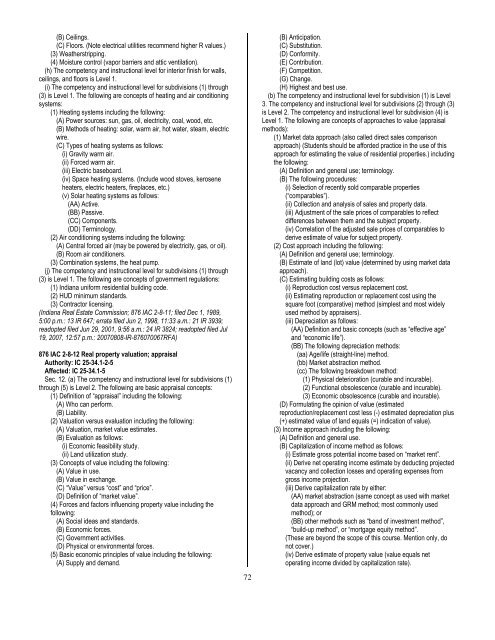Indiana Real Estate Commission Laws and Regulations
Indiana Real Estate Commission Laws and Regulations
Indiana Real Estate Commission Laws and Regulations
You also want an ePaper? Increase the reach of your titles
YUMPU automatically turns print PDFs into web optimized ePapers that Google loves.
(B) Ceilings.<br />
(C) Floors. (Note electrical utilities recommend higher R values.)<br />
(3) Weatherstripping.<br />
(4) Moisture control (vapor barriers <strong>and</strong> attic ventilation).<br />
(h) The competency <strong>and</strong> instructional level for interior finish for walls,<br />
ceilings, <strong>and</strong> floors is Level 1.<br />
(i) The competency <strong>and</strong> instructional level for subdivisions (1) through<br />
(3) is Level 1. The following are concepts of heating <strong>and</strong> air conditioning<br />
systems:<br />
(1) Heating systems including the following:<br />
(A) Power sources: sun, gas, oil, electricity, coal, wood, etc.<br />
(B) Methods of heating: solar, warm air, hot water, steam, electric<br />
wire.<br />
(C) Types of heating systems as follows:<br />
(i) Gravity warm air.<br />
(ii) Forced warm air.<br />
(iii) Electric baseboard.<br />
(iv) Space heating systems. (Include wood stoves, kerosene<br />
heaters, electric heaters, fireplaces, etc.)<br />
(v) Solar heating systems as follows:<br />
(AA) Active.<br />
(BB) Passive.<br />
(CC) Components.<br />
(DD) Terminology.<br />
(2) Air conditioning systems including the following:<br />
(A) Central forced air (may be powered by electricity, gas, or oil).<br />
(B) Room air conditioners.<br />
(3) Combination systems, the heat pump.<br />
(j) The competency <strong>and</strong> instructional level for subdivisions (1) through<br />
(3) is Level 1. The following are concepts of government regulations:<br />
(1) <strong>Indiana</strong> uniform residential building code.<br />
(2) HUD minimum st<strong>and</strong>ards.<br />
(3) Contractor licensing.<br />
(<strong>Indiana</strong> <strong>Real</strong> <strong>Estate</strong> <strong>Commission</strong>; 876 IAC 2-8-11; filed Dec 1, 1989,<br />
5:00 p.m.: 13 IR 647; errata filed Jun 2, 1998, 11:33 a.m.: 21 IR 3939;<br />
readopted filed Jun 29, 2001, 9:56 a.m.: 24 IR 3824; readopted filed Jul<br />
19, 2007, 12:57 p.m.: 20070808-IR-876070067RFA)<br />
876 IAC 2-8-12 <strong>Real</strong> property valuation; appraisal<br />
Authority: IC 25-34.1-2-5<br />
Affected: IC 25-34.1-5<br />
Sec. 12. (a) The competency <strong>and</strong> instructional level for subdivisions (1)<br />
through (5) is Level 2. The following are basic appraisal concepts:<br />
(1) Definition of “appraisal” including the following:<br />
(A) Who can perform.<br />
(B) Liability.<br />
(2) Valuation versus evaluation including the following:<br />
(A) Valuation, market value estimates.<br />
(B) Evaluation as follows:<br />
(i) Economic feasibility study.<br />
(ii) L<strong>and</strong> utilization study.<br />
(3) Concepts of value including the following:<br />
(A) Value in use.<br />
(B) Value in exchange.<br />
(C) “Value” versus “cost” <strong>and</strong> “price”.<br />
(D) Definition of “market value”.<br />
(4) Forces <strong>and</strong> factors influencing property value including the<br />
following:<br />
(A) Social ideas <strong>and</strong> st<strong>and</strong>ards.<br />
(B) Economic forces.<br />
(C) Government activities.<br />
(D) Physical or environmental forces.<br />
(5) Basic economic principles of value including the following:<br />
(A) Supply <strong>and</strong> dem<strong>and</strong>.<br />
72<br />
(B) Anticipation.<br />
(C) Substitution.<br />
(D) Conformity.<br />
(E) Contribution.<br />
(F) Competition.<br />
(G) Change.<br />
(H) Highest <strong>and</strong> best use.<br />
(b) The competency <strong>and</strong> instructional level for subdivision (1) is Level<br />
3. The competency <strong>and</strong> instructional level for subdivisions (2) through (3)<br />
is Level 2. The competency <strong>and</strong> instructional level for subdivision (4) is<br />
Level 1. The following are concepts of approaches to value (appraisal<br />
methods):<br />
(1) Market data approach (also called direct sales comparison<br />
approach) (Students should be afforded practice in the use of this<br />
approach for estimating the value of residential properties.) including<br />
the following:<br />
(A) Definition <strong>and</strong> general use; terminology.<br />
(B) The following procedures:<br />
(i) Selection of recently sold comparable properties<br />
(“comparables”).<br />
(ii) Collection <strong>and</strong> analysis of sales <strong>and</strong> property data.<br />
(iii) Adjustment of the sale prices of comparables to reflect<br />
differences between them <strong>and</strong> the subject property.<br />
(iv) Correlation of the adjusted sale prices of comparables to<br />
derive estimate of value for subject property.<br />
(2) Cost approach including the following:<br />
(A) Definition <strong>and</strong> general use; terminology.<br />
(B) Estimate of l<strong>and</strong> (lot) value (determined by using market data<br />
approach).<br />
(C) Estimating building costs as follows:<br />
(i) Reproduction cost versus replacement cost.<br />
(ii) Estimating reproduction or replacement cost using the<br />
square foot (comparative) method (simplest <strong>and</strong> most widely<br />
used method by appraisers).<br />
(iii) Depreciation as follows:<br />
(AA) Definition <strong>and</strong> basic concepts (such as “effective age”<br />
<strong>and</strong> “economic life”).<br />
(BB) The following depreciation methods:<br />
(aa) Age/life (straight-line) method.<br />
(bb) Market abstraction method.<br />
(cc) The following breakdown method:<br />
(1) Physical deterioration (curable <strong>and</strong> incurable).<br />
(2) Functional obsolescence (curable <strong>and</strong> incurable).<br />
(3) Economic obsolescence (curable <strong>and</strong> incurable).<br />
(D) Formulating the opinion of value (estimated<br />
reproduction/replacement cost less (-) estimated depreciation plus<br />
(+) estimated value of l<strong>and</strong> equals (=) indication of value).<br />
(3) Income approach including the following:<br />
(A) Definition <strong>and</strong> general use.<br />
(B) Capitalization of income method as follows:<br />
(i) Estimate gross potential income based on “market rent”.<br />
(ii) Derive net operating income estimate by deducting projected<br />
vacancy <strong>and</strong> collection losses <strong>and</strong> operating expenses from<br />
gross income projection.<br />
(iii) Derive capitalization rate by either:<br />
(AA) market abstraction (same concept as used with market<br />
data approach <strong>and</strong> GRM method; most commonly used<br />
method); or<br />
(BB) other methods such as “b<strong>and</strong> of investment method”,<br />
“build-up method”, or “mortgage equity method”.<br />
(These are beyond the scope of this course. Mention only, do<br />
not cover.)<br />
(iv) Derive estimate of property value (value equals net<br />
operating income divided by capitalization rate).


